Agronomy Update
Sep 09, 2024
Response to Sulfur Fertilization in Lentils
Canola growers are familiar with the sulfur requirements of that crop, and it is becoming more common knowledge that sulfur is also important for maximizing spring wheat and durum yield. In fact it is one of the top three nutrients necessary for those crops. A minimum 10 lb./ac application rate is recommended for durum and spring wheat regardless of soil test results, as the soil test is not considered diagnostic by soil scientists. Now, research from Montana State University led by Dr. Perry Miller has shown that sulfur fertilization improves yield and nitrogen fixation in lentils.Studies were conducted at four sites in Montana and three sites in North Dakota from 2019 to 2021 to determine the effect of sulfur fertilization and inoculation on lentil nitrogen fixation and yield. The sulfur levels evaluated were 0 and 5 lb./ac applied as potassium sulfate. Avondale was the variety used and the studies were conducted under no-till conditions. More details about the study sites, methods and results can be found on the MSU website.
Application of just 5 lbs./ac of sulfur increased yield in 20% of study sites. The yield response to sulfur did not correlate to soil sulfate-S levels, which was anticipated due to the high mobility of this compound and the variability in its concentration across a field. The image below is from the Bozeman 2020 site and demonstrates the visible response to sulfur. The plot on the left (no sulfur) is clearly less green than the plot that received sulfur (right).
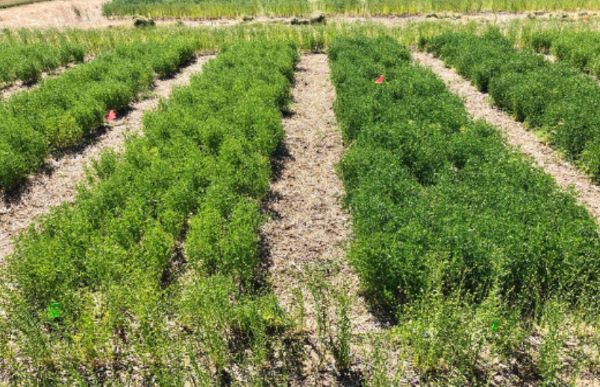
Sulfur application improved nitrogen fixation at 20% of sites. In the Bozeman 2020 site, that resulted in 30 lb./ac more fixed nitrogen in the sulfur fertilized plots. Sulfur application also has the potential to increase the amount of nitrogen left over for the next crop (graph below).

While fixed nitrogen was removed from the field at harvest with the seed (bottom line with open circles; ~ 80 lbs./ac), the samples with higher sulfur levels in the tissue exceeded this removal level (top line with black circles; up to 140 lbs./ac), meaning that the fixed nitrogen will remain in the field as crop residue and as it breaks down be available for future crops.
Given that we cannot reliably predict the response of lentil crops to sulfur fertilization with a soil test, routine application is recommended to prevent yield loss and reduction of nitrogen fixation. This is one of the reasons that Horizon Resources carries the Mosaic MicroEssentials S10 product rather than 11-52-0-0 as a starter. The S10 applied at 50 lbs./ac will provide the 5 lbs./ac shown to boost yield and nitrogen fixation in lentils.
To learn more about the study I discussed above, check out the Growing Pulse Crops podcast episode with Professor Clain Jones, soil fertility specialist with Montana State University.
Dr. Audrey Kalil, Agronomist/Outreach Coordinator
Fall Burn Down
One of the most effective ways to keep fields clean for next year is controlling weeds in the fall, which many of us do in the form of fall residuals. Fall residuals like Valor have proven to be an extremely important tool for the control of weeds like Narrow Leaf Hawksbeard and Kochia in a pulse crop rotation. But what about right now? Did you know that when you leave kochia escapes that made it under the cutter bar at harvest (like the picture below) they are a BIG contributor to the seed bank you keep battling come next spring?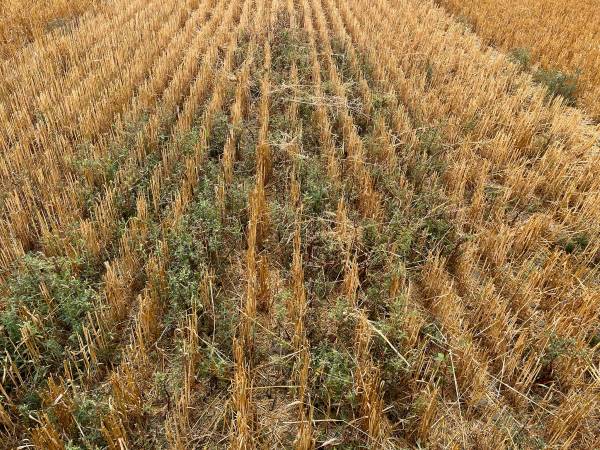
Ignoring these weeds for weeks after harvest or until they freeze up gives them so much time for re-growth, and they are good at it. Remember those weeds you cut at harvest were only partially cut and were already mature with a well-developed root system that can grow new shoots with new seed in just days. Why let those weeds add more seeds to the seed bank? It’s simple to get out now right now and burn off what’s out there so it can’t add more seed for you to control next year.
Here are three of my favorite go-to tank mixes for burning down post-harvest: paraquat + a non-ionic surfactant, glyphosate + Saddle-Up + Class Act NG, and glyphosate + 2,4D LV6 + Class Act NG.
Paraquat + NIS
This gets nicknamed the ultimate gunslinger, and for good reason. It will fry anything the spray pattern touches, especially in the current weather we have with 75+ degrees and sunny. But this is also its weakness, you must spray a high-water volume of 20 gallons per acre or more, and even then,
sometimes you don’t get 100% brown dead weeds, especially if they are big plants.
Glyphosate + Saddle-Up + Class Act NG
Pick your favorite glyphosate at 32 oz/ac and add Saddle-Up at 16 oz, and make sure you use the full 2.5 gallons per 100 gallons H2O of Class Act NG. Sometimes 16 oz of Saddle-Up isn’t enough in the dry weather following harvest and 24 oz is a more warranted rate. The Dicamba & 2,4D in Saddle- Up are in an acid formulation and have much better foliar activity in warm weather vs the amine formulation that is in Brash. You can use this mix on any rotation but going to pulse crops for the following season, dicamba can be touchy, especially on lentil if the weather remains dry throughout the fall.
Glyphosate + LV6 + Class Act NG
Basically, a copy and paste of the mix previously stated but instead of Saddle up you are using 16-24 oz of 2,4D LV6. This is my mix when doing post-harvest burndown in fields I know are going to pulse crops. It’s not as sharp on kochia as Paraquat or Saddle-Up but it does provide activity and suppress growth which is what the goal is, to stop further seed production.
Kyle Okke, Crop Consultant, CCA
Management of Wheat Stem Sawfly
Wheat Stem Sawfly has been an important pest of spring wheat and durum in North Dakota since the early 1900s, with yield losses ranging from 10 to up to 100% in recent years. Winter wheat can be affected as well. The yield loss and reduced kernel weight which occurs in infested crops is due to the larval stage damaging the stem, impacting nutrient and water uptake and eventually causing lodging. Lodging due to sawfly has been reported in several fields in our area this year. Below is a map of the 2024 IPM survey of wheat stem sawfly which is conducted by NDSU showing the distribution of this pest across the state. While we can’t undo the damage that has already occurred, there are some steps you can take next season to reduce yield loss due to this pest.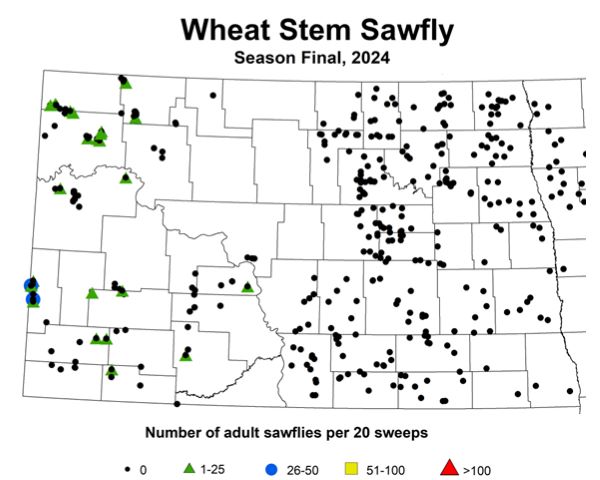
To manage wheat stem sawfly it helps to understand the biology of this insect. The adult stage is short lived and typically lays its eggs inside host stems in mid to late June. The egg hatches to produce a larvae which feeds on the interior stem tissue. Prior to harvest the larva moves to the base of the stem and chews a notch around the inside of the stem which weakens and ultimately breaks it. The larva overwinter in the remaining stubble. This means infested fields from this year, along with wild grasses which can also be infested, will be the source of this pest next season.
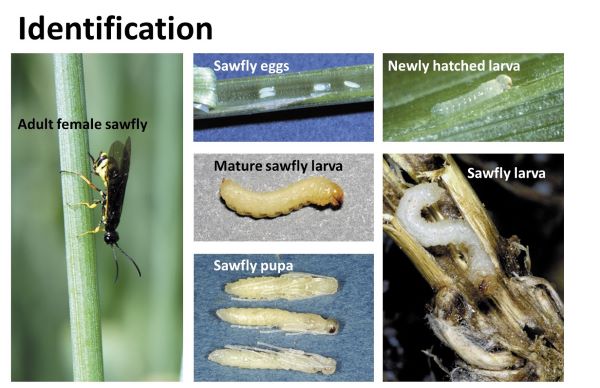
Parasitic wasps, Bracon cephi and B. lissogaster, are a very important means of controlling wheat stem sawfly, and these are also found in the overwintering crop stem residue (picture below). For this reason, tillage is not effective at controlling wheat stem sawfly. In fact, you want to cut as high as possible or use a stripper header to preserve the wasps. Crop rotation to oats, canola, soybean, sunflower or pulse crops can help but not eliminate the pest as it can travel long distances. Solid and semi-solid stemmed winter wheat (Loma, AC Lillian), spring wheat (Mott, SY Longmire, CP 3322, CP3055, CP3119A) and durum (AAC Stronghold) are more tolerant to damage caused by wheat stem sawfly and can outyield hollow stemmed varieties under heavy sawfly pressure.
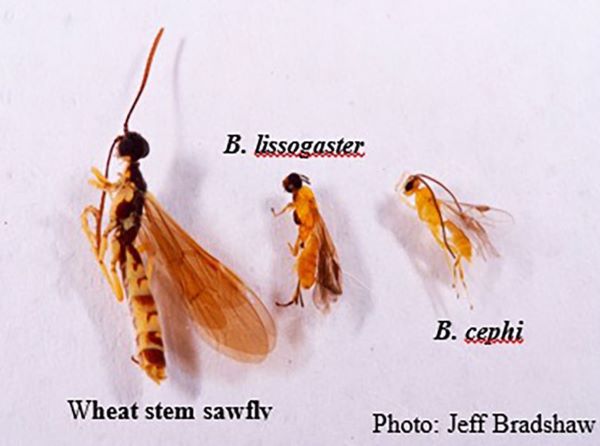
Unfortunately, insecticides are really not effective against wheat stem sawfly. The larval stage is protected in the stem, and adults escape control due to migration, their long window of infestation (up to a month), and limited pesticide exposure as the adult stage doesn’t eat or drink. You also risk killing the beneficial parasitic wasp.
Where sawfly was problematic this year, rotate to non-host crops next year and consider planting solid or semi-solid stemmed variety of spring wheat or durum on nearby fields. Oats can act as a trap crop as the sawfly will lay eggs in the stems but are unable to compete their lifecycle resulting in 100% mortality. Their inclusion in a crop rotation could suppress the wheat stem sawfly populations in the future.
Dr. Audrey Kalil, Agronomist/Outreach Coordinator